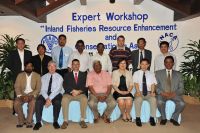Inland Fisheries Resource Enhancement and Conservation in Indonesia
2 July 2010 | Maskur | 3853 views | .mp3 | 5.42 MB | Genetics and Biodiversity, Indonesia, Inland aquaculture, Stock enhancement
Indonesia has inland water area of 13.85 million ha. The inland fish production has increased steadily and significantly from 288 666 tonnes in 1998 to 494,395 tonnes in 2008. Fisheries resources conservation development in Indonesia is based on the protection of endangered and vulnerable freshwater species and maintaining biodiversity integrity, and has been developed with community participation. In order to increase the population and diversification of fish species in inland waters stock enhancement was carried out since the Dutch occupation when more than 17 species were stocked in inland waters in Indonesia. Those restocking and stock enhancement activities have been done since 1912, and since 2000 fish stock enhancement programs are in natural lake, floodplains area, and man-made lake based on scientific assessment data. The species used for stock enhancement were planktivorous, herbivorous, periphyton feeding and omnivorous species.
The purpose of stock enhancement and conservation are mainly to maintain and sustain populations of fish stock, increasing sustainable fish production and to protect endemic species, fish fauna ecosystems, as well as to maintain the populations of vulnerable and endangered species. Moreover, stock enhancement in Indonesia also aims to mitigate the negative impact due to overloading of the system from cage culture activities in reservoirs. The Ministry of Marine Affairs and Fisheries (MMAF) is the responsible authority for the development of stock enhancement and conservation in Indonesia. MMAF has issued a number of decrees to facilitate the objectives of fisheries enhancement and conservation. Financial aspects for inland fisheries stock enhancement and conservation generally was initiated by the Central or local government covering the purchase of fingerlings and transportation costs. Generally fish seed used for stock enhancement is from the government fish hatcheries and overall it is a public activity conducted by the authorities for public good.
Creative Commons Attribution.
